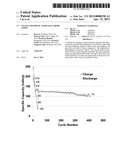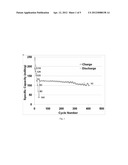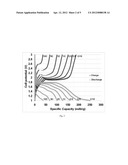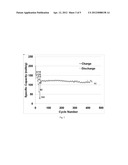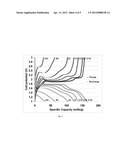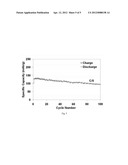Patent application title: Titania-Graphene Anode Electrode Paper
Inventors:
Jun Liu (Richland, WA, US)
Daiwon Choi (State College, PA, US)
Wendy D. Bennett (Kennewick, WA, US)
Gordon L. Graff (West Richland, WA, US)
Gordon L. Graff (West Richland, WA, US)
Yongsoon Shin (Richland, WA, US)
IPC8 Class:
USPC Class:
4292315
Class name: Electrode chemically specified inorganic electrochemically active material containing vanadium (v), chromium (cr), niobium (nb), molybdenum (mo), titanium (ti), or tungsten (w) component is active material
Publication date: 2012-04-12
Patent application number: 20120088158
Abstract:
A method for forming a nanocomposite material, the nanocomposite material
formed thereby, and a battery made using the nanocomposite material.
Metal oxide and graphene are placed in a solvent to form a suspension.
The suspension is then applied to a current collector. The solvent is
then evaporated to form a nanocomposite material. The nanocomposite
material is then electrochemically cycled to form a nanocomposite
material of at least one metal oxide in electrical communication with at
least one graphene layer.Claims:
1. A method for forming a nanocomposite material comprising the steps of:
providing metal oxide and graphene in a solvent to form a suspension,
applying said suspension to a current collector, evaporating the solvent
to form a nanocomposite material comprising at least one metal oxide in
electrical communication with at least one graphene layer.
2. The method of claim 1 wherein the solvent is an organic solvent.
3. The method of claim 1 wherein the metal oxide is titania.
4. The method of claim 1 wherein the titania is provided as particles having an average diameter below 50 nm.
5. The method of claim 1 wherein the titania is provided as particles having an average diameter below 10 nm.
6. A method for forming a nanocomposite material comprising the steps of: providing metal oxide and graphene in a solvent to form a suspension, applying said suspension to a current collector, evaporating the solvent to form an anode, connecting the anode to a cathode having lithium ions and an electrolyte to form a battery, electrochemically cycling the anode to form a nanocomposite material comprising at least one metal oxide in electrical communication with at least one graphene layer.
7. The method of claim 6 wherein the solvent is an organic solvent.
8. The method of claim 6 wherein the metal oxide is titania.
9. The method of claim 6 wherein the titania is provided as particles having an average diameter below 50 nm.
10. The method of claim 6 wherein the titania is provided as particles having an average diameter below 10 nm.
11. A nanocomposite material formed by the steps of: providing metal oxide and graphene in a solvent to form a suspension, applying said suspension to a current collector, evaporating the solvent to form a nanocomposite material comprising at least one metal oxide in electrical communication with at least one graphene layer.
12. The nanocomposite material of claim 11 wherein the solvent is an organic solvent.
13. The nanocomposite material of claim 11 wherein the metal oxide is titania.
14. The nanocomposite material of claim 11 wherein the titania is provided as particles having an average diameter below 50 nm.
15. The nanocomposite material of claim 11 wherein the titania is provided as particles having an average diameter below 10 nm.
16. The nanocomposite material of claim 11 further comprising the step of connecting the anode to a cathode having lithium ions and an electrolyte to form a battery, and electrochemically cycling the anode
17. A battery formed by the process of: providing metal oxide and graphene in a solvent to form a suspension, applying said suspension to a current collector, evaporating the solvent to form an anode, providing a cathode and an electrolyte in electrical communication with said anode, electrochemically cycling the anode to form a nanocomposite material comprising at least one metal oxide in electrical communication with at least one graphene layer as part of said anode.
18. The battery of claim 17 wherein the solvent is an organic solvent.
19. The battery of claim 17 wherein the metal oxide is titania.
20. The battery of claim 17 wherein the titania is provided as particles having an average diameter below 50 nm.
21. The battery of claim 17 wherein the titania is provided as particles having an average diameter below 10 nm.
Description:
TECHNICAL FIELD
[0002] This invention relates to nanocomposite materials with unique and useful electrochemical properties. These nanocomposite materials are formed of graphene and metal oxides. The invention has particular utility when used in batteries and particularly in lithium ion batteries.
BACKGROUND OF THE INVENTION
[0003] There have been a number of examples of methods for forming nanomaterials using graphene and metal oxides to take advantage of the unique electrochemical properties of graphene. For example, U.S. patent application Ser. No. 12/462,857 filed Aug. 10, 2009 describes nanocomposite materials having at least two layers. Each layer consists of one metal oxide bonded to at least one graphene layer. The nanocomposite materials will typically have many alternating layers of metal oxides and graphene layers, bonded in a sandwich type construction and will be incorporated into a electrochemical or energy storage device.
[0004] U.S. patent application Ser. No. 12/553,527 filed Sep. 3, 2009 describes a nanocomposite material formed of graphene and a mesoporous metal oxide having a demonstrated specific capacity of more than 200 F/g with particular utility when employed in supercapacitor applications. These nanocomposite materials by forming a mixture of graphene, a surfactant, and a metal oxide precursor and then precipitating the metal oxide precursor with the surfactant from the mixture to form a mesoporous metal oxide. The mesoporous metal oxide is then deposited onto a surface of the graphene.
[0005] These and other prior art devices typically form the nanocomposite materials using a metal oxides in a salt form, such as lithium titanate (Li4Ti5O.sub.12,) as a precursor material. While this Li4Ti5O.sub.12 material has been shown to work well in these applications, it is expensive and thus may not be suited for certain high volume applications.
[0006] Many of these metal oxides are widely known as inexpensive materials, but are also widely known as poor electrical conductors. For example, titania of the form TiOx in its common forms of its anatase or rutile is widely known as an inexpensive material, but is also widely known as a poor electrical conductor. Therefore, those of ordinary skill in the art have not used these metal oxides, such as titania, as an anode material, or in applications where it would be a precursor to an anode material.
[0007] Accordingly, there exists a need for low cost metal oxides that can be successfully utilized as an anode material, or as a precursor to an anode material in applications where it would be combined with graphene. The present invention fulfills that need.
SUMMARY OF THE INVENTION
[0008] The present invention is therefore a method for forming a nanocomposite material using low cost commodity chemicals as starting materials. The present invention proceeds by first providing metal oxide and graphene in a solvent to form a suspension. The suspension is then applied to a current collector. The solvent is then evaporated to form a nanocomposite material which has at least one metal oxide in electrical communication with at least one graphene layer. Preferably, the solvent is an organic solvent, the metal oxide is titania, and the titania is provided in a particle form wherein the particles have an average diameter below 50 nm, and more preferably below 10 nm.
[0009] In one embodiment, the present invention is a method for forming a nanocomposite material that includes the steps of providing metal oxide and graphene in a solvent to form a suspension. The suspension is then applied to a current collector. The solvent is then evaporated to form an anode. The anode is connected to a cathode having lithium ions and an electrolyte to form a battery. The anode is then electrochemically cycled to form a nanocomposite material of at least one metal oxide in electrical communication with at least one graphene layer.
[0010] In another embodiment, the present invention is a nanocomposite material formed by providing metal oxide and graphene in a solvent to form a suspension. The suspension is then applied to a current collector. The solvent is then evaporated to form an anode. The anode is connected to a cathode having lithium ions and an electrolyte to form a battery. The anode is then electrochemically cycled to form a nanocomposite material of at least one metal oxide in electrical communication with at least one graphene layer. Preferably, the solvent is an organic solvent, the metal oxide is titania, and the titania is provided in a particle form wherein the particles have an average diameter below 50 nm, and more preferably below 10 nm. The nanocomposite material of the forgoing embodiment may further be formed by the steps of connecting the anode to a cathode having lithium ions and an electrolyte to form a battery and electrochemically cycling the anode.
[0011] In another embodiment, the present invention is a battery formed by providing metal oxide and graphene in a solvent to form a suspension. The suspension is then applied to a current collector. The solvent is then evaporated to form an anode. A cathode and an electrolyte are then provided in electrical communication with the anode. The anode is connected to a cathode having lithium ions and an electrolyte to form a battery. The anode is then electrochemically cycled to form a nanocomposite material of at least one metal oxide in electrical communication with at least one graphene layer. Preferably, the solvent is an organic solvent, the metal oxide is titania, and the titania is provided in a particle form wherein the particles have an average diameter below 50 nm, and more preferably below 10 nm.
BRIEF DESCRIPTION OF THE DRAWINGS
[0012] The following detailed description of the embodiments of the invention will be more readily understood when taken in conjunction with the following drawing, wherein:
[0013] FIG. 1 is a graph of the cycling performance of TiO2/Graphene composite electrodes made by one embodiment of the present invention at various C rates using 2.6 micron graphene.
[0014] FIG. 2 is a graph of the charge/discharge voltage profiles of TiO2/Graphene composite electrode at various C rates of between C/10 and 10 C using 2.6 micron graphene.
[0015] FIG. 3 is a graph of the cycling performance of TiO2/Graphene composite electrodes made by one embodiment of the present invention at various C rates using 11.6 micron graphene.
[0016] FIG. 4 is a graph of the charge/discharge voltage profiles of TiO2/Graphene composite electrode at various C rates of between C/10 and 10 C using 11.6 micron graphene.
[0017] FIG. 5 is a graph of the cycling performance of TiO2/Graphene composite paper electrodes prepared from an aqueous suspension.
DETAILED DESCRIPTION OF THE PREFERRED EMBODIMENTS
[0018] For the purposes of promoting an understanding of the principles of the invention, reference will now be made to the embodiments illustrated in the drawings and specific language will be used to describe the same. It will nevertheless be understood that no limitations of the inventive scope is thereby intended, as the scope of this invention should be evaluated with reference to the claims appended hereto. Alterations and further modifications in the illustrated devices, and such further applications of the principles of the invention as illustrated herein are contemplated as would normally occur to one skilled in the art to which the invention relates.
[0019] Several experiments were conducted to demonstrate various alternative embodiments of the present invention. In the first of these experiments, an aqueous method using a film type application was shown for forming titania/graphene composites of 90/10 wt % and 72/28 wt % (P-25).
[0020] To prepare the 90:10 (wt %) titania:graphene suspensions, 23 mg graphene (Vorbeck Materials LLC) was dispersed in 50 ml H2O using 2.3 mg (10 wt %) CTAB (cetyl trimethylammonium bromide) surfactant and ultrasonicated for 15 minutes. For the 72:28 (wt %) titania:graphene suspensions, 77.8 mg of graphene (Vorbeck Materials LLC) was dispersed in 50 ml H2O using 7.78 mg CTAB (cetyl trimethylammonium bromide) surfactant and ultrasonicated for 15 minutes. In a second container, 200 mg nanosized titania powder (Degussa P25) was dispersed in 50 ml H2O by stirring and ultrasonic mixing for 10 minutes then slowly added to the graphene suspension. The final suspension was then mixed for an additional 4 hours. After mixing, the titania:graphene suspension is filtered, air dried then calcined at 400° C. in a H2/Ar atmosphere for 3 hours.
[0021] To prepare test electrodes, 0.5 ml of poly(vinylidene fluoride) (PVDF) binder dispersed in N-methylpyrrolidone (NMP) solution (0.5 g/20 ml) was added to 0.1125 g of the composite powder and homogenized for 10 minutes. The final slurry was then coated on an Al current collector using a roll applicator to a thickness of approximately 60 microns. Slurry rheology was adjusted using NMP content and viscosities in the range of approximately 1000-5000 cps, which produced good quality films. After drying on a hot plate for 5 minutes, circular test electrodes were made using a 9/16'' punch. The half-cells (2325 coin cell, National Research Council, Canada) with polypropylene membrane separator (Celgard, Inc.), Li metal anode and reference in 1M LiPF6 in EC/DMC (1:1 v/v) (ethyl carbonate/dimethyl carbonate) electrolyte were assembled in a glove box (Mbraun, Inc.) filled with ultra highly purity (UHP) argon. The electrochemical performance of the TiO2/graphene anode was then evaluated using an Arbin Battery Tester BT-2000 (Arbin Inst., College Station, Tex.) at room temperature. The half-cell was tested between 3V and 1V vs. Li at various C rate current based on a theoretical capacity of 168 mAh/g (i.e., 1 C=168 mAhg-1) for anatase. In the next set of these experiments, an aqueous method using a tape application was shown for forming titania/graphene composites of 90/10 wt % and 72/28 wt % (P-25).
[0022] To prepare the 90:10 (wt %) titania:graphene suspensions, 23 mg graphene (Vorbeck Materials LLC) was dispersed in 50 ml H2O using 2.3 mg (10 wt %) CTAB (cetyl trimethylammonium bromide) surfactant and ultrasonicated for 15 minutes. For the 72:28 (wt %) titania:graphene suspensions, 77.8 mg of graphene (Vorbeck Materials LLC) was dispersed in 50 ml H2O using 7.78 mg CTAB (cetyl trimethylammonium bromide) surfactant and ultrasonicated for 15 minutes. In a second container, 200 mg nanosized titania powder (Degussa P25) was dispersed in 50 ml H2O by stirring and ultrasonic mixing for 10 minutes then slowly added to the graphene suspension. The final suspension was then mixed for an additional 4 hours. After mixing, the titania:graphene suspension was filtered, air dried then calcined at 400° C. in a H2/Ar atmosphere for 3 hours.
[0023] For the preparation of P-25/graphene tapes (90 wt % P-25), 222.2 mg of graphene was dispersed in 250 mL H2O using 23 mg of CTAB surfactant and sonicated for 15 min. In a separate container, 2.0 g P-25 was dispersed in 100 mL water by sonication (10 min). The P-25 suspension was slowly added to the graphene dispersion upon stirring and stirred for 4 h. The slurry was filtered, air-dried, and calcined at 400° C. in a H2/Ar for 3 h.
[0024] To prepare P-25/graphene composite tapes, the calcined powder was first dispersed in water and 7 wt % of PTFE suspension (65 wt % in water, Aldrich) was added upon stirring. After 3 additional hours stirring, the mixture was filtered and dried at 90° C. for 30 min. The powder/PTFE green body was then calendared to the desired thickness (˜1-100 microns) using a three-roll mill.
[0025] Circular test electrodes were made using a 9/16'' punch and dried overnight at 110° C. in a vacuum oven. The half-cells (2325 coin cell, National Research Council, Canada) with polypropylene membrane separator (Celgard, Inc.), Li metal anode and reference in 1M LiPF6 in EC/DMC (1:1 v/v) (ethyl carbonate/dimethyl carbonate) electrolyte were assembled in a glove box (Mbraun, Inc.) filled with ultra highly purity (UHP) argon. The electrochemical performance of the TiO2/graphene anode was then evaluated using an Arbin Battery Tester BT-2000 (Arbin Inst., College Station, Tex.) at room temperature. The half-cell was tested between 3V and 1V vs. Li at various C rate current based on a theoretical capacity of 168 mAh/g (i.e., 1 C=168 mAhg-1) for anatase.
[0026] FIG. 5 shows the cycling performance of the titania/graphene composite anodes produced using the aqueous film method. The anode shows a good initial capacity of approximately 120 mAh/g and approximately 20% capacity fade after 100 cycle at a C/5 rate.
[0027] In the next set of these experiments, a non-aqueous method also using a film application was shown for forming titania/graphene composites of 90/10 wt % and 72/28 wt % (P-25).
[0028] Nanosized titania powder (Degussa P25) and graphene (Vorbeck Materials LLC) were dispersed in NMP using ultrasonic mixing (30 min) in 90:10 and 72:28 wt % ratios. Total solids loadings between approximately 3-12 wt % were typically used in preparing the initial suspensions. To these slurries 10 wt % (relative to the solids content) of PVDF binder was added and the mixture stirred 5-16 h and homogenized if needed. Slurry rheology was adjusted using NMP and viscosities in the range of approximately 1000-5000 cps, which produced good quality films.
[0029] The final slurry was then coated on an Al current collector using a roll applicator at a thickness of approximately 60 microns. After drying on a hot plate for 5 minutes, circular test electrodes were made using a 9/16'' punch. The half-cells (2325 coin cell, National Research Council, Canada) with polypropylene membrane separator (Celgard, Inc.), Li metal anode and reference in 1M LiPF6 in EC/DMC (1:1 v/v) (ethyl carbonate/dimethyl carbonate) electrolyte were assembled in a glove box (Mbraun, Inc.) filled with ultra highly purity (UHP) argon. The electrochemical performance of the TiO2/graphene anode was then evaluated using an Arbin Battery Tester BT-2000 (Arbin Inst., College Station, Tex.) at room temperature. The half-cell was tested between 3V and 1V vs. Li at various C rate current based on a theoretical capacity of 168 mAh/g (i.e., 1 C=168 mAhg-1) for anatase.
[0030] FIGS. 1-4 show the measured specific capacity at various C rates and voltage profiles for the half cells prepared using this method. FIGS. 1 and 2 were measured on titania/graphene composites made from graphene with an average particle size of 2.6 μm. The samples had high initial capacity (>170 mAh/g at C/10) and good rate capability (>100 mAh/g at 2 C). Less that 5% capacity fade occurred after 200 cycles at 1 C, after which the fading rate increased slightly. The sample retained a specific capacity of approximately 100 mAhr/g after 400 hours cycling at 1 C.
[0031] The data in FIGS. 3 and 4 was collected on titania/graphene composites made from graphene with an average particle size of 11.6 μm. These samples had even better specific capacity, rate performance and cycling stability than those prepared using the smaller (2.6 μm) graphene particles. Negligible fade occurs after 400 cycles at 1 C in these samples. While the invention has been illustrated and described in detail in the drawings and foregoing description, the same is to be considered as illustrative and not restrictive in character. Only certain embodiments have been shown and described, and all changes, equivalents, and modifications that come within the spirit of the invention described herein are desired to be protected. Any experiments, experimental examples, or experimental results provided herein are intended to be illustrative of the present invention and should not be considered limiting or restrictive with regard to the invention scope. Further, any theory, mechanism of operation, proof, or finding stated herein is meant to further enhance understanding of the present invention and is not intended to limit the present invention in any way to such theory, mechanism of operation, proof, or finding.
[0032] Thus, the specifics of this description and the attached drawings should not be interpreted to limit the scope of this invention to the specifics thereof. Rather, the scope of this invention should be evaluated with reference to the claims appended hereto. In reading the claims it is intended that when words such as "a", "an", "at least one", and "at least a portion" are used there is no intention to limit the claims to only one item unless specifically stated to the contrary in the claims. Further, when the language "at least a portion" and/or "a portion" is used, the claims may include a portion and/or the entire items unless specifically stated to the contrary. Likewise, where the term "input" or "output" is used in connection with an electric device or fluid processing unit, it should be understood to comprehend singular or plural and one or more signal channels or fluid lines as appropriate in the context. Finally, all publications, patents, and patent applications cited in this specification are herein incorporated by reference to the extent not inconsistent with the present disclosure as if each were specifically and individually indicated to be incorporated by reference and set forth in its entirety herein.
User Contributions:
Comment about this patent or add new information about this topic:
| People who visited this patent also read: | |
| Patent application number | Title |
|---|---|
| 20200377570 | IMPROVED LAMP CONSTRUCTS |
| 20200377569 | SYNTAC POLYPEPTIDES AND USES THEREOF |
| 20200377568 | Novel IL-4-/IL-13-derived peptide compounds for the treatment or prevention of neurodegenerative or neuroinflammatory diseases |
| 20200377567 | METHODS OF TREATMENT USING G-CSF PROTEIN COMPLEX |
| 20200377566 | MODIFIED LIGAND-GATED ION CHANNELS AND METHODS OF USE |

